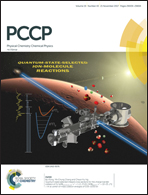The influence of particle size of amino-functionalized MCM-41 silicas on CO2 adsorption†
Abstract
The CO2 adsorption properties of hybrid organic–inorganic MCM-41 silicas with different particle sizes are described here. Micrometric to nanometric MCM-41 silicas are functionalized by introducing amino groups via grafting of 3-[2-(2-aminoethyl)aminoethyl]aminopropyltrimethoxysilane (PAPTS). A combination of FTIR and SS-NMR spectroscopies is adopted to distinguish between physisorbed and chemisorbed CO2. A higher amount of CO2 is physisorbed in the nanometric sample because of a higher pore volume, whereas chemisorbed (carbamate and acid carbamic) species are more abundant in the micrometric sample. The adsorption process is also quantitatively studied using three different techniques (i.e. volumetric measurements, Thermo-Gravimetric Analysis (TGA) and Zero Length Column (ZLC) analysis), especially focusing on the reversibility of the reactions between CO2 and amino groups. The three techniques show a higher CO2 adsorption capacity for MCM-41 with nanometric size compared to the micrometric one. Finally, the process is studied at different temperatures (i.e. from 35 to 90 °C) in order to find the best operating conditions.



 Please wait while we load your content...
Please wait while we load your content...